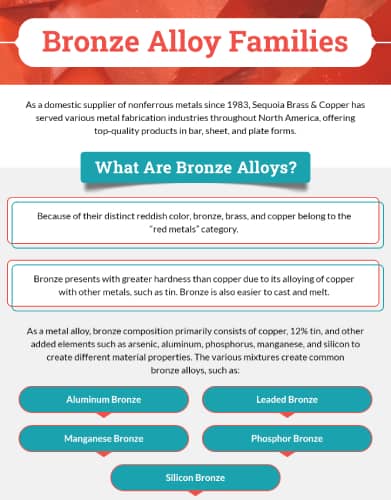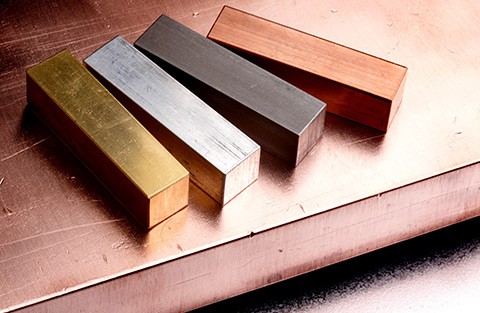At Sequoia Brass & Copper, we work hard to earn the confidence and trust of our customers by maintaining high expectations for our products and services. Our team believes in delivering superior customer service and developing innovative ways to meet the needs of customers who require quality metal products.
As a domestic supplier of nonferrous metals since 1983, we have served various metal fabrication industries throughout North America, offering top-quality products in bar, sheet, and plate forms.
Sequoia Brass & Copper is passionate about customer satisfaction, providing the best in materials and communication, and our commitment to quality shines in everything we do. Learn more about the bronze alloys we supply, including their properties and applications.
What Are Bronze Alloys?
Because of their distinct reddish color, bronze, brass, and copper belong to the “red metals” category. Bronze presents with greater hardness than copper due to its alloying of copper with other metals, such as tin. Bronze is also easier to cast and melt.
As a metal alloy, bronze composition primarily consists of copper, 12% tin, and other added elements such as arsenic, aluminum, phosphorus, manganese, and silicon to create different material properties. The various mixtures create common bronze alloys, such as:
- Aluminum bronze
- Leaded bronze
- Manganese bronze
- Phosphor bronze
- Silicon bronze
Properties of Bronze Alloys
Bronze’s unique properties make it beneficial in computer electronics, artwork, and many other applications. The most common bronze properties include the following:
Hardness
Brittleness (albeit less brittle than cast iron)
Melting point of 950 °C
High corrosion resistance from saltwater
Low metal-to-metal friction
High ductility
Reddish-brown color
One of the most unusual properties of bronze alloys is their ability to expand slightly when transforming from a liquid into a solid. This can be a desirable feature, especially in sculpture casting because it helps to fill the mold.
When exposed to air, the outer layer of bronze oxidizes. This copper oxide patina eventually transforms into copper carbonate. The oxide layer offers protection for the interior metal, preventing further corrosion. However, when exposed to chlorides like seawater, copper chlorides begin to form, causing “bronze disease,” a condition where corrosion gradually destroys the metal.
When struck against a hard surface, bronze doesn’t create sparks. This unique property makes it especially useful when working with explosive or flammable materials.
Applications of Bronze Alloys
The unique characteristics of bronze make it highly suitable for use in aesthetic and functional applications. Here is an overview of the most common bronze uses.
Types of Bronze
The following types of bronze are the most commonly used for a wide variety of applications:
Phosphor Bronze
Also called tin bronze, phosphor bronze contains copper, up to 0.35% phosphorus, and approximately 11% tin. Adding phosphorus to the composition increases the stiffness and wear resistance of the bronze alloy. This durable alloy has a reputation for being tough, with a fine grain and low coefficient of friction. Phosphor bronze is beneficial in creating electrical components, musical instruments, anti-corrosive equipment, springs, washers, and bellows.
Aluminum Bronze
This type of bronze contains copper and 6% to 12% aluminum. Other additional elements can include iron, manganese, nickel, and silicon. Aluminum bronze has corrosion-resistant properties and can be especially useful in marine hardware, pumps carrying corrosive fluids, and other harsh applications. The tarnish-resistant is often used in the petrochemical, water supply, and oil industries.
Silicon Bronze
Sometimes referred to as red silicon bronze, this alloy contains copper, zinc, and as much as 6% silicon. Other compositions of silicon bronze can include manganese, iron, tin, and zinc. It has high-strength properties with benefits that include high corrosion resistance, an appealing surface finish, and easy pouring. Valve and pump parts commonly utilize silicon bronze.
Manganese Bronze
The composition of manganese bronze consists of 3% manganese, zinc, iron, copper, and aluminum. It resists shock and tends to deform instead of break. The material is also resistant to saltwater corrosion, making it an ideal metal for boat propellers. Manganese bronze can also prove beneficial in creating gears, nuts, bolts, valves, and pump parts.
Bearing Bronze
This unique material has a lead content ranging between 6% and 8%, giving it low-friction properties useful in high-wear environments. Bearing bronze is the preferred choice for applications that are difficult to maintain or access. As the name implies, bearing bronze is most commonly used to make bushings and bearings.
Copper-Nickel Bronze
Also called cupronickel, copper-nickel bronze has a higher composition of nickel, ranging between 2% and 30%. Similar to other bronze alloys, the material has exceptional durability and corrosion-resistant properties, particularly against saltwater. Copper-nickel bronze has high thermal stability and is typically used to create marine equipment, electronic components, pumps, and valves.
Bismuth Bronze
This material contains between 1% and 6% of bismuth to create a highly corrosive-resistant material with superior thermal conductivity and malleability. Bismuth bronze polishes well and proves a suitable metal for mirrors, light reflectors, kitchenware, bearings, and other industrial applications.
Bronze Alloys From Sequoia Brass & Copper
Sequoia Brass & Copper offers a wide range of bronze alloy materials to meet the specific demands of many applications, including industrial, marine, electrical, healthcare, and artistic projects. We offer a full range of compositions of bronze alloys in sheet, rod, tube, plate, and bar form to meet the specific needs of our customers.
Contact us at (510) 887-5525 or request a quote to learn more about how Sequoia Brass & Copper can help you with your next application.







